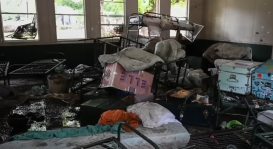
This year's flu outbreak has now officially reached epidemic proportions as 22 states are reporting unusually high cases and 15 children have died so far nationwide.
The Centers for Disease Control and Prevention are reporting a spike in "influenza-like" cases this week that show a much more dangerous and mutated strain of the flu bug that isn't stopped by the traditional flu shot.
Known as H3N2, this strain of the flu makes up more than 90% of the cases this season, and is said to be especially harmful to children. But the worst of it is yet to come. "Though we cannot predict what will happen the rest of this flu season, it's possible we may have a season that's more severe than most," CDC Director Dr. Tom Frieden stated during a press conference.
Currently, the H3N2 flu is affecting every region of the country, but a heavy concentration is felt particularly in the south. Six of the 15 child deaths have been in Tennessee so far, and the state's East Tennessee Children's Hospital has already seen 442 cases of the flu in children this month alone.
Since flu vaccines are created each year based on the predicted mutation of the regular flu strains (including H1N1, H3N2, and H1N2), it's difficult to predict and stock enough of the vaccines for the right areas. For example, the Northern Hemisphere has a different vaccine than the Southern Hemisphere, and a combination of different epidemic strains can join forces to become a mutation that wasn't predicted. Resistance to traditional flu drugs has proven to increase year after year, as both amantadine and rimantadine have gone from a 1% resistance in 1994 to a 91% resistance in 2005. Doctors are advising those who feel they may have the flu to take new, heartier drugs like Tamiflu and Relenza.
Each strain of flu is named for its molecule types that surround the outside of the virus. According to Dr. Pritish Tosh, an infectious diseases physician with the Mayo Clinic and a member of the Mayo vaccine research group, there are 17 different types of H particles (hemagglutinin) that allow the binding to take place. Nine different N particles (neuraminidase) act as the catalyst to allow the virus to spread. The H3 subtypes are the ones that cause the largest number of hospitalizations and deaths.
But despite the fact that the current flu vaccine has proven to be ineffective against this year's worst flu strain, some experts are blaming those who opt not to get the flu shot as a possible reason for the spread.
"The one thing we know about influenza is that it is unpredictable," said Patsy Stinchfield, the director of infection prevention and control with Children's Hospitals and Clinics of Minnesota. "We don't fully understand why but low vaccination rates may have something to do with areas getting hit harder."
The timeline is also confusing doctors. The peak of the flu season was traditionally around February or March, but in recent years, that peak has come earlier and earlier.
As for symptoms, Dr. Karyl Rattay, the director of Delaware's Division of Public Health, said that they're not any different than those you'd experience with the common flu. Those symptoms include fever, aching muscles, and respiratory problems. But the H3N2 strain is much more dangerous than the common flu, especially to children, the elderly, pregnant women, those who suffer from asthma, and those with immune deficiencies.
"It is just hard to know how high your peak is going to be and when you are going to see it," Rattay continued. "We only really know when we look in the rear view mirror."
If you're concerned about the concentration of flu in your area, check out Google's flu trend map for more regional information.







